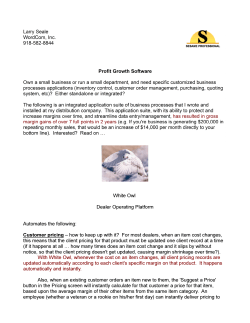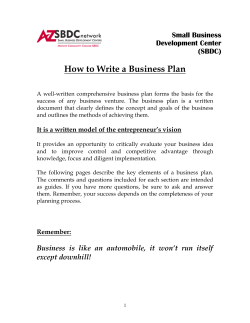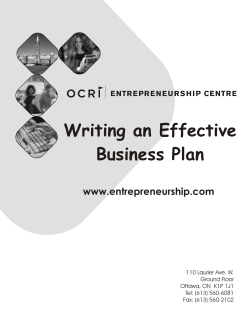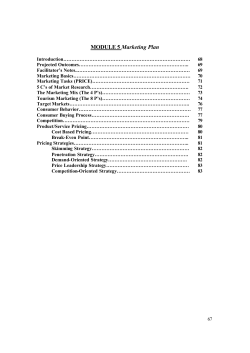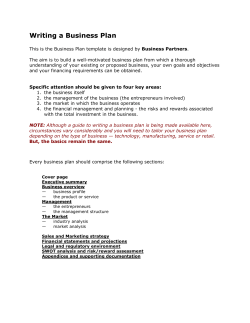
How to Develop a Business Plan
How to Develop a Business Plan A guide to help you understand what is required when developing a business plan for your new venture This guide has been prepared to help you to better understand what is required when developing a business plan for your new venture. It can help you to appreciate why you need a plan and what it should contain as well as offering guidance on the practical process of assembling the various components of the plan. How to Develop a Business Plan The guide is structured as follows: Why do you need a business plan? .................................................................3 How should you structure your business plan? .............................................4 What research do you need to complete? ......................................................5 What should be included in each of the 14 headings of your plan? .............6 1. Executive Summary ................................................................................................................... 6 2. Name of business and contact details ......................................................................................... 6 3. Business owners and/or directors ............................................................................................... 7 4. The business............................................................................................................................. 7 5. Products, services, customers and marketing ............................................................................ 10 6. Staff details .............................................................................................................................. 4 7. Legal Status .............................................................................................................................. 4 8. Names of Advisers .................................................................................................................... 4 9. Suppliers .................................................................................................................................. 4 10. Business Assets ..................................................................................................................... 19 11. Business risks and response to risks ....................................................................................... 20 12. The Project ........................................................................................................................... 22 13. Request for Finance............................................................................................................... 22 14. Financial Information ............................................................................................................. 23 Conclusion ......................................................................................................24 2 Why do you need a business plan? This is a valid question asked by all operators when planning to establish a small business and it vital from the very outset that you see the importance of preparing a business plan, no matter how small your proposed venture is. The four most important reasons for having a plan are: The plan is your roadmap: without clear direction (goals, strategy and plans) for your business, how are you going to achieve your vision for the venture? How will you know what the potential for your business is likely to be in Year 1, and beyond that to Years 2 and 3? The most important function of the plan is that it is your document, it clarifies and structures your ideas, formalises your financial plans and maps out how you will market and then manage the business. You develop the plan for yourself first, not for others; but of course it has many other uses such as being a requirement when seeking funding, or serving as a communication tool for informing stakeholders about your proposals. It is really important to understand that you should never develop your plan solely for others, do it for yourself because it will help you to maximise your potential for success. The plan is necessary for investors/lenders: it is unlikely that anyone, outside of your family and close friends that is, will be willing to support you financially, if you cannot produce a realistic business plan. A well-structured and fact-based plan demonstrates to the bank, and other possible funders, that you are serious about your proposal and that you have given careful thought to the future direction of your business. Although, as just stated, you don’t prepare the plan just for others, it is important nonetheless to structure it in a manner that meets the needs of lenders/investors; consequently, the business plan format shown later in this guide is considered to be a recommended approach by leading financial institutions in Ireland. The plan can help you track progress: as part of preparing your plan, you will set clear goals and objectives for your business which can later be used to help you measure progress. The plan tests the feasibility of your business idea: completing the plan helps you to check the practicality of your ideas in the sense that the research you conduct, and the discussions you will have with independent advisors in compiling the plan, will serve to test the feasibility of your proposals. Maybe, when viewed under the microscope, your idea doesn’t stack up as well as you first thought, but even if you find that negative outcomes arise from the planning process, isn’t it better to know this before you invest all your time and money? 3 How should you structure your business plan? Many business owners avoid preparing a business plan because the task seems too onerous or time consuming. This is a mistake and one of the most common causes of business failure is poor planning. There is no pretence that preparing a plan for your business is going to be an entirely painless activity, but it is a vital one in terms of maximising your chances for success. For most small businesses, the plan does not have to be an overly complicated document, although at the same time, you should understand that it will take you time and effort to put it together and that certain information is required to make the plan worthwhile. In tackling the development of your business plan, you can structure the information as follows: 1. 2. 3. 4. 5. 6. 7. 8. 9. 10. 11. 12. 13. 14. Executive summary Name of business and contact details Business owners and/or directors The business Products, services, customers and marketing Staff details Legal status Names of advisers Suppliers Business assets Business risks and response to risks The project Request for finance Financial information 4 There are many alternative options for structuring your plan and this 14Heading format above has been aligned with the helpsheet prepared by the Consultative Committee of Accountancy Bodies - Ireland (CCAB-I) and the Irish Banking Federation as to what a good business plan should entail. In that sense, by following this framework, you will be meeting the requirements of most financial institutions as regards what they expect to see in a business plan. On first glance, this might seem like an excessive amount of data for a small business, but don’t be fooled into believing that the smaller the business the less the need for planning. Actually, you might argue the opposite is true because whereas a larger business might be able to absorb the effects of poor planning, a small business most certainly will not. That said, under each of the 14 headings above it is the quality and not the quantity of information which is of importance. What research do you need to complete? Your business plan must be based on fact not fiction and to achieve that aim you must conduct research. Generally, those seeking to establish new businesses are eager to get going, so they can find the research process most challenging. However, it’s worth the effort you put into it because solid research will ultimately make for a better business and will certainly increase the chances of success. In short, there are two types of research: Primary research is new research that you compile yourself. For example, you might conduct surveys of potential customers, or if passing trade was important to your business idea, you could assess the footfall outside the location for your business. If possible, seek professional advice when seeking to conduct primary research as expertise in survey design and research methodology will make for better results. Secondary research is using existing data sources such as industry analysis, trade journals, newspapers, magazines, census data, and demographic profiles. Thanks to the internet, this type of research is now far more accessible today than it once was. One point is worth bearing in mind when conducting your research. It is not unusual for the budding entrepreneur to ‘fall in love’ with their idea to the extent that they ignore the warning signs thrown up by the research. It is good to be passionate about your proposals but you need to remain entirely objective too and judge the findings of your research impartially. 5 What should be included in each of the 14 headings of your plan? This section of the guide will provide you with specific details as to what should be included in each section of your plan. 1. Executive Summary The executive summary section is a snapshot of the highlights of your business plan and is usually the last thing you write. For a standard business plan, the executive summary generally includes the following information: 1. Purpose of the plan 2. Market opportunity 3. Management team 4. Track record, if any 5. Financial projections 6. Funding requirements As well as summarising your plan, you should keep in mind that the executive summary must grab the attention of the reader. In many cases, this is the section that is read first and if you fail to excite them about your proposals, then they will be unlikely to read any further. In that sense the executive summary is your chance to ‘sell’ as well as ‘tell’. 2. Name of business and contact details The information required here is relatively straightforward and would include items such as: Business name Legal form of ownership Business address Telephone Business website Main contact name (Promoter) Main contact telephone and email address 6 3. Business owners and/or directors Here you need to provide details on the background, qualifications and experience of those who will be directly involved in establishing and running the business. This is vital information for anyone intending to invest in, or fund your enterprise, and it is important that you clearly demonstrate what each individual will bring to the venture. Even if you, or others who will be involved, do not have direct experience in the proposed field of the new business, you will have other experience and it is important that you show how that background can help in starting this enterprise. Preparing this section also provides you with an opportunity to really think about whether you, and those who will be involved in the business, have what is required to make it work. Maybe you might benefit from bringing an additional partner into the business that would bridge certain skills and/or knowledge gaps? 4. The Business In this section of the plan, you need to provide the following information: 4.1 Business Here you should try to briefly address the following questions: What type of business are you proposing? What is the business concept? What business/sector will you be operating in? Broadly, what will your offering entail? What are your general aims and goals for the business? Where is it located? What facilities/amenities will it include? Who will the customers be? Who will your competitors be? The key objective here is to provide an overview to the reader as to what your business will involve, why it is necessary, who will use it and who you will compete against. A business idea doesn’t have to be totally new to appeal to an investor or lender, but it does have to meet a defined need or gap in the market and that is what you are trying to highlight here. 7 4.2 Operations Here you should describe how the business will operate and what you include here will depend upon the nature of your business, but may address points such as: How the business will operate: opening hours, seasonality, etc. What facilities and resources are available to the business? How will you manage quality and service standards? What suppliers will be used, what are their credentials? What are your plans for Health and Safety for employees and customers? What Environmental and Waste Management proposals do you have? First and foremost this type of information is important for you, as you need to think how you will operate the business to a high standard. However, it also shows the reader of the plan that you have given due consideration to how the business will operate as a going concern and that you have thought beyond Day 1. 4.3 Key trends in the sector Here you should address the following questions: What are the key trends in the sector? For example, how is the sector structured, large or small businesses, many or few players? Is there an over/under supply of the type of product or services you propose to offer? What are the overall growth projections for the sector in your region? What supports are available for businesses such as yours? Are you maximising your usage of those supports? Who are the main trade associations? Do you have a relationship with them? This is vital information for you to have researched because if you haven’t done so then you cannot really demonstrate the potential for your proposals, as you lack real insights into the sector/industry you are entering. From the reader’s perspective, this section will help them to better understand the dynamics of the sector, if they do not know already, but even if they do know this information, the fact that you have included it will give them further confidence that you have really done your homework on the sector/industry. 4.4 Vision for the business An important consideration for any new business operator is whether they have considered the long-term future of their business proposal. Having a dream is a good thing, but it is also important to translate that vision into a sentence or two which describes what you ultimately want to achieve in your business. That’s what you need to do here, summarise your vision statement for the business. 8 Some business owners see the goal as being to get the business off-the-ground, but that should only be a milestone on a longer journey of creating a business which makes a difference in some shape or form. Yes, you want to make money from your proposal, nothing wrong with that, but in the process of doing so you want the business to stand for something, or be the best in the field you are entering, or whatever your vision might be. 4.5 Mission for the business Mission on the other hand contains a few sentences which describe what type of business you will operate as you work towards that vision and outlines what you will do for key stakeholders such as owners/investors, customers and employees. This is an important statement for a number of reasons: First, it makes you think about the type of business you wish to run with regard to key stakeholders. Second, for an outsider to the business, it tells them something about you as a business person and what your beliefs and values are. develop concrete goals with strategies to achieve your mission and vision 4.6 Goals and overall strategy Vision and Mission statements are important as indicators of intent, but you need more than that in terms of managing a successful business of any size. The sentiments contained within these statements must be brought to life through the development of concrete goals with strategies to achieve them. In this section of the plan you should address the following questions: What measurable goals are you trying to achieve in areas like sales, profit, customer satisfaction, employee satisfaction, etc. Goals bring your vision and mission to life because they translate those aspirations into targets which are Specific, Measurable, Achievable, Realistic and Time bound (SMART). For example, your mission might include a statement that you want to provide an adequate return on investment for your investors (if you have them). To make that more concrete you would set a specific target for profitability, or return on investment. What strategy (or strategies) will you follow to achieve your goals and targets? In other words, using the above example, how will you achieve the defined profitability or return on investment target? 9 5. Products, services, customers and marketing 5.1 Products and Services Here you should try to address the following questions across three dimensions: 5.1.1 Features of your products and services What products and/or services will you offer? Here you should seek to describe the range of products and services you will offer in the business. 5.1.2 Uniqueness of your products and services What is special or unique about your offering? Even if you are entering a crowded field (or perhaps more importantly if you are) you need to show how your products and services will be different and better than what is already available. What factors will give you competitive advantages or disadvantages over others? Here you should also explain how you will promote and sell the uniqueness of your products and/or services in your sales and marketing messages. 5.1.3 Benefits of your products and services What are the most important benefits of your offering? What will your offering do for the customer? What will they gain from using your products and/or services? In essence the reader should have a clear picture of what your business is offering and why it is special or unique. 10 5.2 Customers Here you are trying to summarise the dynamics and trends with regard to your targeted customers. Address the following questions: To whom will you market your products and services? Who are your targeted customers? Give as many details as you can about them, their characteristics, and their geographic locations; i.e., demographics. You may well have many customer segments so, for each main consumer group, construct what is called a demographic profile: Age Gender Location Income level Social class/occupation Education develop a good understanding of consumer behaviour Buying behaviour Although you may not include this in the plan itself, as part of your research, you should develop a good understanding of the consumer behaviour relevant to your business. This includes answering questions such as: What customers buy? How often? For example, in your various market segments, what are their different buying/usage patterns? How do they buy? Direct, online, through intermediaries? Why do they buy? What are they expecting from you? Studying consumer behaviour provides you with the information you need to develop your offering, set prices, identify distribution channels, create marketing messages and develop other marketing activities. As part of this, try also to understand the buying process which is often depicted as containing the following distinct stages: 1. 2. 3. 4. 5. Problem recognition Information search Evaluation of alternatives Purchase decisions Post-purchase behaviour 11 5.3 Marketing Marketing is of course a vital activity for any business so you need to be very clear as to what your plans in this area are going to be. In particular, you need to define clearly what your overall marketing strategy will entail. To guide your thinking in this section, and although not wholly applicable to new businesses, there are four general marketing strategies that can be considered. These have been adapted here to help you to understand the general marketing strategies you might follow at various stages of the life cycle of your business: Market Entry (New Offering/New Market) Your product/service will be new (maybe not unique but it is a new business) and you will be seeking to develop new markets. Market Penetration (Existing Products/Existing Markets) You have secured a foothold in the markets you targeted; now you want to expand your customer base within those markets. Market Development (Existing Offering/New Market) As you establish the business and become more familiar with the market composition and dynamics you may identify new markets you can exploit with your existing offering. Product Development (New Offering/Existing Market) When you have established a successful operation you may then decide to introduce an entirely new offering to meet changing or unmet needs you have identified amongst your existing customer base. These four approaches are simply intended to give you an indication of the broad marketing strategies you may follow over time and to highlight that your marketing strategy will evolve along with the business. In terms of preparing your business plan, you will be required to provide the following information: a clear logic and rationale to the various activities planned 5.3.1 Main Marketing Activities In this section, you should provide details on the main marketing activities you have planned and describe how those activities will generate sales for the business. Your marketing activities might include things like various promotions, direct selling/ attendance at trade shows, advertising and special offers etc. It is important to demonstrate that there is a clear logic and rationale to the various activities planned and that they are not simply selected at random. 12 5.3.2 Market Trends Although earlier in the plan you summarised trends in the sector/industry, here you are trying to describe the dynamics and trends in the market(s) you will be operating in which will involve addressing questions such as: Are you operating in a mass market, or do you offer a specialist or niche experience? Is overall demand growing, or subsiding? What drives the market(s) that you will operate in: price, quality or both? What trends are prevalent in those markets? How does the market operate? Do customers generally buy directly, online or through intermediaries, or all three? Who are these intermediaries and what relationships do you have with them? How is technology affecting the market dynamics? Will you have a lot of competitors, or only a few (remember, competitors are not just those who are located close by)? 5.3.3 Market Research Here you need to summarise what marketing research you have conducted which has helped you to identify target markets, define your strategy, prepare you marketing plans and decide on the most effective marketing activities. For an outsider to your business, this will be important to give them confidence that there is a sound basis for your marketing proposals. 5.3.4 Pricing Strategy Pricing is one of the most important decisions you will take in business life - get it wrong and you will likely find yourself in serious financial trouble at some point. This is a very detailed area and more information can be found in the Understanding Costs and Profit guide and the Dealing with Pricing Challenges guide. In this part of the business plan, you should address the following questions: What will your pricing strategy be? How important is price as a competitive factor for your business? It is important to remember that, even in tough operating times, customers may not care as much about price as you might think – it’s often value they are focused upon, not solely price. Does your pricing strategy fit with what was revealed in your competitive analysis? Compare your prices with those of the competition. Are they higher, lower, the same? Why? For most small businesses, having the lowest price is not necessarily a good policy as it can deny you the required profit margin and create the wrong image for your business. What will be your customer service and credit policies? Briefly, there are a number of approaches that you can adopt when setting prices: 13 Mark-Up Pricing Mark-up pricing is used frequently, particularly in the pricing of food and beverage menus, and is normally based on: The mark-up you must add to the cost of your products and services to achieve the desired profit. The mark-up used by your competitors. The mark up, which is usually expressed as a percentage, is added to the cost of the product to achieve the selling price. Different businesses apply different mark-up rates on the basis of demand, competition, quality and perception. High quality products and services normally support a high mark-up. Margin Based Pricing Margin based pricing indicates the percentage of profit that a business makes on a sale, after applying the mark-up. The higher the mark-up of your products and services, the more lucrative your business could be. It is expected that different products and services will have different profit margins. You should attempt to limit the number of low margin products and services that you offer and to maximise the number of high margin products and services that you offer. Value Based Pricing Value based pricing focuses on the price that customers are willing to pay. The perceived value of a product or a service to a customer may be driven by: Convenience - your accessibility to the market, or in certain cases, your opening hours. Brand or image – if your product is perceived to have a premium image or brand, customers will pay more for it. Supply and demand – if demand for your products and services is high, then you may be in a position to increase your prices. A general point is worth remembering here. It is always easier to reduce the prices of your offering than it is to increase them; as a result, if you are unsure as to the prices you should set, opt for a higher price initially. Then, if your sales volumes do not materialise you should be prepared to reduce your price. 14 Pricing Tactics It is also worth highlighting the various price tactics employed in businesses of all kinds: Odd Value – instead of pricing a bedroom at €100 or a meal at €25, pricing them at €99.95 and €24.95 respectively creates a favourable impression. Loss leaders – selling a small number of products and services at cost will win new customers. However, reducing your profit margin on those products and services that are big sellers only makes sense if you can increase your total sales volume to the extent that the additional profit earned is more than the profit margin foregone by the introduction of your loss leader pricing policy. Price War – is the policy of deliberately undercutting rivals' prices to win market share. Such a strategy could backfire if your competitors respond similarly or if, having achieved market share, you are unable to increase prices and retain your customers. Up Selling – is the process of increasing your sales to your current customers by encouraging them to purchase more expensive goods or services than they intended. This is frequently achieved in restaurants where well trained staff may encourage diners to order an aperitif or an additional bottle of wine. Customers often respond positively to such suggestions Value Added Offers – offering customers additional perceived high value products or services at a competitive price, but which adds very little cost to your business. 5.3.5 Distribution Strategy In this section, you should clearly answer some key questions: What are the main distribution channels associated with your offering? How will you use those channels to sell your offering to Irish and overseas customers? Detailed information on distribution channels in tourism is provided in the How to Create a Marketing Plan online guide, but briefly the channels can be: Direct Consumer Via Travel Agent and/or Tour Operator 15 Direct to Consumer Simplest form of distribution, no intermediary between you and your customers. The internet has facilitated the direct provision of information to customers and enhanced direct purchase options for them. Via Travel Agents and/or Tour Operators You use intermediaries to distribute your offering including travel agents and tour operators. Travel agents and tour operators can now operate on- and offline while online travel agents (OTAs) represent the fastest growing distribution channel in tourism. Travel agent access to Global Distribution System (GDS) and Computer Reservation System (CRS) has also extended their reach. Whilst a significant proportion of your customers will find you by themselves, (either online or through your other marketing and promotional channels), it’s important to know about the different distribution channels and how they are likely to impact both on your product and your costs. know about the different distribution channels and their impact 5.3.6 Promotion In this section you should address the following questions: What image do you want to project for your offering? How do you want customers to view you? Premium, niche or mass-market offering? How will you get the word out to your targeted customers? What are your plans for advertising? What media will be used, why, and how often? Why this mix and not some other? What are your online and social media plans? Will you use methods other than paid advertising, such as trade shows, word of mouth (how will you stimulate it?), network of friends or professionals? What plans do you have for other promotional supports? This includes things like logo design, cards and letterhead, brochures, signage, etc. What will your promotional budget be? At start-up phase? On an on-going basis? Is this sufficient to achieve your marketing and business goals? In essence, in this section you need to summarise your promotions strategy, the channels you will use to reach your target market: this will likely include engaging in sales, public relations and e-marketing activities. 16 5.3.7 Marketing Spend Naturally, there needs to be realistic projections of what you can do in terms of your marketing plans, so it is vital that you show what you propose to spend on marketing for the first three years of business operations. This should be prepared in line with your sales projections. You may wish to do two forecasts: a best and worse-case scenario. An external investor/lender will look closely at all financial data you provide and particularly so your ability to fund the marketing of your business to the level required. Some new business operators have detailed marketing plans and proposals but they lack the resources to provide them which defeats the purpose; it is vital that you can demonstrate that what you are proposing is feasible and that it will lead to sales increases. 6. Staff details Previously in the plan you have outlined the background and experience levels of those involved in establishing the business i.e. you, and any other founders. In this section, if relevant, you need to outline who else will be working in the business. This may include: 6.1 Management team Will you be recruiting a management team? If so, what key functions will be covered (e.g. operations, finance, HR, sales, etc.), how many individuals will be involved, what will their experience levels be and so on? 6.2 Employees If you are recruiting employees (full and/or part-time), you need to provide details here of proposed staffing levels. 6.3 Staffing Plan In addition to the above, you should provide a staffing plan. This plan shows when the various posts will be filled, which will be at start-up phase and which will come on stream as the business develops and the relevant costs associated with these posts. You should also include details here on the HR policies and procedures you intend to apply for areas such as recruitment, training and development, leadership and so on. Don’t be put off by the thoughts of providing this information because even if there are very few people involved in your business, you still want to explain your overall philosophy for bringing the best out of those people and that’s what the staffing plan does. 17 7. Legal Status In this section you should describe the legal structure of the business (sole trader, partnership or limited company) and, if appropriate, offer an explanation on why you chose that particular legal format. This is important information for investors/lenders as certain types of structure offer more protection to them than others, i.e. they have little or no protection when investing in a Sole Trader and as such would want some form of personal guarantees for any funding provided. Here too you would provide the names and holdings of the shareholders as well as the directors where the structure is a limited company. It is also useful to highlight the key legislation and regulation that applies to the operating of your business (planning requirements, licences, registration, compliance with tax legislation, etc.). Obviously, you need to be aware of this yourself, but from an outsider’s perspective, by providing this information you are further demonstrating that you have clearly thought through all aspects of establishing and running the proposed business. 8. Names of Advisers If you are using external advisors or support, it is important to identify who they will be and by doing so you demonstrate that you are calling on appropriate expertise to help run the business professionally. The details you provide here might include: The name of your accountant The names of other professionals who might be supporting you The names of strategic partners you might be working with In today’s competitive environment, even a very small business needs external support and any lender/investor would be concerned by any business person seeking to go it entirely alone. 9. Suppliers In many businesses, the ability to deliver quality products for customers is dependent upon the effectiveness of the suppliers used. Here you should provide the names of your proposed key suppliers, the products/services to be provided by them and the reasons for choosing them (as opposed to alternative suppliers). Also give details of contracts and terms (payment, delivery, quality, quantity, etc.) already agreed or to be agreed. Again, by providing this information, you are demonstrating that you have considered this important aspect of running your business and that you are planning to only deal with reputable and high quality suppliers. 18 10. Business Assets There are two components to the information you need to provide here: 10.1 Premises You should provide full details on the premises associated with the business and the legal status of those premises (freehold, leasehold, rented etc.) Where you plan to lease or rent the premises you should provide details of terms, amount of rent/lease payable, frequency of payment, leased term, years remaining, rent review periods etc. 10.2 Equipment In addition, you should provide information on the current and proposed equipment needed (including vehicles, furniture and fittings), together with details on costs, funding, current value and when they will be fully owned / paid off. 19 11. Business risks and response to risks All new businesses represent a risk, and by researching and preparing a detailed business plan for your venture you are taking concrete steps towards reducing the risk levels associated with your venture. However, you will always be faced with risks and it is important that you have proactively identified what they are, or might be, and made some contingency plans, if not to eradicate them, then to respond to them effectively if and when they arise. Therefore, in this section you should address the following issues: 11.1 Key risks affecting the business You should list the key actual/potential risks affecting the business and how you propose to respond to them. 11.2 Competitors You should list the key competitors (even those beyond your local area) and what they are doing to attract customers to their products and services. As part of this you should describe the ways in which your competitors are successful and areas where they weak, in terms of product offering, price, service, quality, promotions, etc. and the approaches you will take to respond to competitive pressures. Describe what you will do to consolidate your markets, develop and retain a loyal customer base and how you will continuously innovate to stay ahead of your competitors. carry out a SWOT analysis The next few sections of the business plan can be described as your SWOT analysis. SWOT analysis is a well-known and highly useful technique for understanding your Strengths and Weaknesses (internal to the business), and for identifying both the Opportunities and Threats (external to the business) you face. 11.3 Business Strengths Here you should describe your strengths (issues under your control that will make your business successful and provide a competitive advantage). Examples of business strengths include unique product, access to finance, contacts, experienced and skilled workforce. 11.4 Business Weaknesses In this part, describe your weaknesses (issues under your control that will prevent you from doing better business). Examples of business weaknesses include lack of financial expertise or poor knowledge of marketing. 20 11.5 External Opportunities Here you should provide an overview of the external opportunities (issues outside your direct control that can be of benefit to your business). Examples of external opportunities include changes in customer spending patterns and new e-marketing methods. 11.6 External Threats In this section, provide an overview of the external threats (issues outside your direct control that have negative consequences for your business). Examples of external threats include the arrival of strong new competitors, worsening economic conditions, escalating costs and increased regulation. 11.7 Other Risks There may be special risks associated with your business which are worth highlighting. For example, if your clients are paying in a currency other than euros, how susceptible are you to interest rate fluctuations in terms of your financial projections? Or maybe your business is in the activity sector which has significant risk issues around health and safety for your customers. How will you respond to such risks? 21 12. The Project You have already provided many details about your business and in this section you need to focus on two particular aspects of its future development: 12.1 Key Milestones Here you should outline the key milestones of the business, with particular emphasis on the stages of development. This could include construction timelines, kit-out, staged opening and further development plans. From your perspective this is important information for you to have considered because, for example, if your new business involves even small pre-opening construction work and that is delayed, how will that impact on your projections? 12.2 Break-even Details Any new business needs to have an indication when it will break-even and you calculate this as a matter of priority. identify funding requirements 13. Request for Finance Very few small businesses can be established without some form of external funding, and as such you will need to determine what the funding requirement will be, where you will source it and what you will use it for. This will require you to provide details on: 13.1 Financial Requirement Here you should provide details of the amount and timing of finance requested, together with a proposed repayment schedule. 13.2 Uses of Finance Here you should offer a detailed description of how funds will be spent and, in the case of loans and other credit, how and when repayment will be funded. 13.3 Sources of Finance Here you should outline any other sources of finance being requested or approved such as investment by the promoter, grant aid, etc. that will supplement the credit finance being sought. 22 14. Financial Information Naturally, the financial information section is a vital element of the overall plan and you should begin with a general summary of how you intend to manage the financial aspects of your business, the reports and information you will have to guide you and any external expertise you might be availing of. In addition, provide details on: 14.1 Current Financing Arrangements Provide information on the current financing arrangements: Names of current lenders Amounts and terms of loans Maturity of loans Covenants Security and guarantees Internally generated capital including directors’ loans, and terms attaching to these, shareholdings and reserves Other sources 14.2 Projected Financial Statements All new businesses, regardless of size, are expected at a minimum to provide the following realistic projections, usually for a three year period: Profit and Loss Accounts This is where you bring together all your sales and expense projections to get an idea of what returns you can make from the business. As mentioned, your sales projections must be realistic, and you must include all operating and other expenses relevant to your business, including your salary. Balance Sheets The balance sheet is another fundamental financial document which any business needs and it shows what items of value are held by the enterprise (Assets), and what its debts are (Liabilities). When liabilities are subtracted from assets, the remainder is known as Owners’ Equity. Cash Flow Statements, indicating peak borrowing requirements Cash flow is the life blood of any business and many operations fail because at some point they simply cannot pay their bills. Every part of your business plan is important, but none of it means a thing if you run out of cash. The objective of the cash flow projection is to define how much cash you can generate on a monthly basis, how much you will pay out and what the surplus/shortfall will be on a monthly and annual basis; remember, you may generate revenue in one month, but not actually get paid for some time after that, so without cash flow projections you can suddenly find yourself in trouble. This is a document you must frequently update, but for your plan it is used to identify what loan or overdraft facilities you might require to run the business. 23 14.3 Key Assumptions If you are making any key assumptions in relation to your financial projections, then you should outline them here. 14.4 Gross Profit Margin Here you should show the gross profit margin you expect for each key product/service you will offer. The Gross Profit Margin is the percentage profit a business makes on a sale. Gross profit is sales revenue less the cost of sales. 14.5 Credit Policy How you deal with credit and payments to others is vital in terms of managing cash flow so you should outline your credit policy relating to Debtors and Creditors. 14.6 Major Expenses Here you should list your major expenses such as payroll, rent, raw materials etc. 14.7 Scenario Analysis Too often, small business operators only have a Plan A in terms of their financial projections or development plans. This is always a risky approach. You should therefore conduct a scenario analysis on your projected financial statements to demonstrate key variations of assumptions, such as variations of sales figures by factors such as 10% or 20%, or variations caused by risk factors identified above. This can also be done via best and worst case scenarios which are designed to show that the business can survive even if the projections fall below expectations. Conclusion This document has outlined the main content headings you need to consider when preparing your business plan. Remember, it is not necessary to have a long and unwieldy plan, just one that is based on solid research and realistic projections which demonstrates what your business will offer, why it is special and unique and how you will make it a success. 24 This guide has been provided to you as part of Fáilte Ireland’s suite of guides and templates in the Business Tools resource. Please note that these resources are designed to provide guidance only. No responsibility for loss occasioned to any person acting, or refraining from action, as a result of the material in this publication can be accepted by Fáilte Ireland. The user shall not market, resell, distribute, retransmit, publish or otherwise transfer or commercially exploit in any form any of the content of this guide. For a full version of the disclaimer, go to the Fáilte Ireland website. Fáilte Ireland 88-95 Amiens Street Dublin 1 www.failteireland.ie © Fáilte Ireland 2013 BT-DBP-C1-0913-4 25
© Copyright 2025

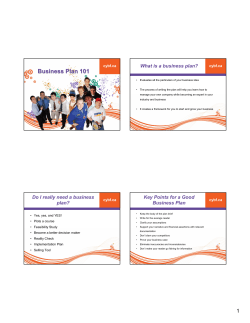

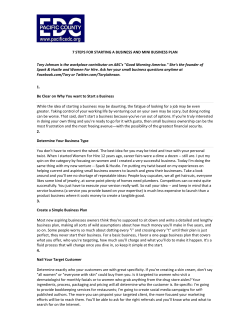

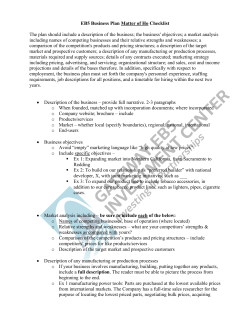
![-- FREE VERSION -- BUSINESS PLAN [Company Logo]](http://cdn1.abcdocz.com/store/data/000167608_1-42df28f9b0d5f3010b555b6dd3118db4-250x500.png)


